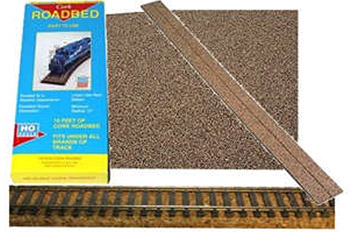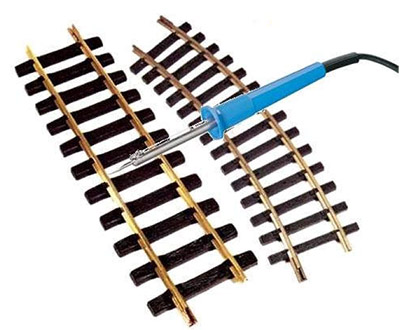Rails, Ties, Roadbed, and Ballast on Your Layout… They All Play a Critical Role in the Smooth Running of a Model Railway
With the benchwork completed, it’s time to get the track laid down. All prototype railroad track is set on ties, which keep the rails in gauge and help prevent the weight of the train from just pushing the track into the ground. Like all transportation systems, railroads love to have a level right of way, so it’s very common to elevate the grade somewhat above the surrounding earth so the roadbed can be made as level as pos-sible. Once this is done and tamped, the ties and rail are placed, and then kept in position by rock ballast of some kind. The amount and grade of ballast on a track section depends on the material the railroad has best (cheapest) access to and the amount and kind of traffic that the section will handle. On main lines with fast and heavy trains, ballast is used liberally to offset the tendency of the rails to shift at high speeds. On spurs, sidings, and lightly used lines, it is common to use much less ballast, or even none at all for very lightly travelled areas. © Copyright http://www.modelbuildings.org All rights reserved.
On a model railroad none of these considerations are of actual use in keeping the track in place, since the ties are molded to the rail to hold the track in gauge. However, sound deadening and authenticity are re-quired for the model, so one of several methods is used to construct the roadbed.
Cork Roadbed Is Cheap and Efficient
The most popular method is preformed cork. Cork roadbed is very easy to work with and comes in inexpensive convenient shapes and/or lengths. Each length can be split down the center so that it can be installed along lines drawn on the layout to indicate the track route. The usual modern method of installation is to use construc-tion adhesive such as Liquid Nails to permanently affix the cork to the layout structure (depending on how permanent you want it to be).
The roadbed has pre-formed shoulders so that the ballast will lie realistically when it is applied. Cork road-bed can also be purchased in special shapes to accommodate turnouts and crossings, but it is easy enough to work with that cutting and splicing your own is not difficult at all.
Cork does a good job of deadening sound, but many modelers also find that a product called Homasote can be used as well. Homasote is a paper based sound deadening material used in building construction, so it doesn’t come in layout-ready sizes.
If you choose to use it, you’ll have to do some cutting and trimming of the product into the correct profile for your line. That process can be messy, but if you are very concerned about noise, the effort will be worth-while. Both Homasote and cork will hold track spikes well, so once the roadbed is complete, the track can be spiked or glued into place.
Track, Curves, Turnouts, Rail Joiners, Easements, Electrical Contact, and Derailments
Flex-track is certainly the easiest to install on a layout. There are several tips to keep in mind when using it. First, one rail is fixed and the other slides in the tie webbing. This can be useful if you offset the rail joiners. Sliding the movable rail out several inches so that the ends of both rails don’t join at the same place can re-duce the possibility of derailing.
Second, install curves and turnouts on your layout first. It’s much easier to cut sections of track to length on a straight segment than it is around a curve or through a turnout. When laying a curve, put the sliding rail to the inside of the curve and trim the excess rail as necessary. Lay out the curve radius with a trammel made from a cheap yard or meter stick with holes drilled to support a pencil or marker at different radii.
Third, consider using easements in your layout design. An easement is a track feature that starts a turn with a very large radius curve that gets tighter as the turn progresses. Prototype railroads use this tech-nique extensively, as it allows the mass of the train to begin changing directions smoothly and for the loco-motive to exert a steady and linear pull throughout the curve without jerking the cars suddenly to the side. Model curve radii are much tighter than real railroads use, and using easements can make the track and train operation look more realistic.
Once the rails are joined, soldering each joint will keep the track trouble free for years. Practice the technique on some scrap rail until you can make a clean joint with good electrical contact. Solder on the outside of the rail to insure that the flanges of the wheelsets are not impaired as they roll over the track.
Laying your track is the one place on the layout that you can exert the most control over how your trains will run. Derailments always seem to happen at the most inconvenient place on the layout. The time you take to do a thorough job of making smooth tracks will be rewarded many times over in great operation with no derailments.



